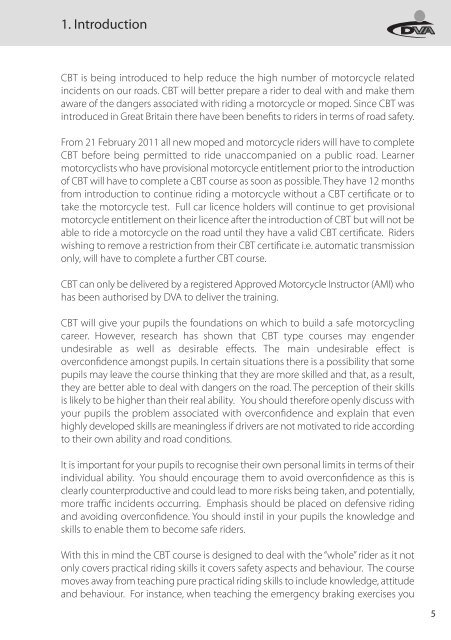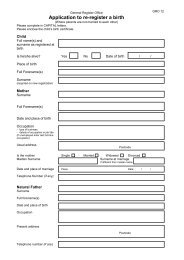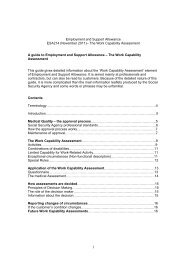an instructors guide to delivering compulsory basic training - NIDirect
an instructors guide to delivering compulsory basic training - NIDirect
an instructors guide to delivering compulsory basic training - NIDirect
You also want an ePaper? Increase the reach of your titles
YUMPU automatically turns print PDFs into web optimized ePapers that Google loves.
1. Introduction<br />
CBT is being introduced <strong>to</strong> help reduce the high number of mo<strong>to</strong>rcycle related<br />
incidents on our roads. CBT will better prepare a rider <strong>to</strong> deal with <strong>an</strong>d make them<br />
aware of the d<strong>an</strong>gers associated with riding a mo<strong>to</strong>rcycle or moped. Since CBT was<br />
introduced in Great Britain there have been benefits <strong>to</strong> riders in terms of road safety.<br />
From 21 February 2011 all new moped <strong>an</strong>d mo<strong>to</strong>rcycle riders will have <strong>to</strong> complete<br />
CBT before being permitted <strong>to</strong> ride unaccomp<strong>an</strong>ied on a public road. Learner<br />
mo<strong>to</strong>rcyclists who have provisional mo<strong>to</strong>rcycle entitlement prior <strong>to</strong> the introduction<br />
of CBT will have <strong>to</strong> complete a CBT course as soon as possible. They have 12 months<br />
from introduction <strong>to</strong> continue riding a mo<strong>to</strong>rcycle without a CBT certificate or <strong>to</strong><br />
take the mo<strong>to</strong>rcycle test. Full car licence holders will continue <strong>to</strong> get provisional<br />
mo<strong>to</strong>rcycle entitlement on their licence after the introduction of CBT but will not be<br />
able <strong>to</strong> ride a mo<strong>to</strong>rcycle on the road until they have a valid CBT certificate. Riders<br />
wishing <strong>to</strong> remove a restriction from their CBT certificate i.e. au<strong>to</strong>matic tr<strong>an</strong>smission<br />
only, will have <strong>to</strong> complete a further CBT course.<br />
CBT c<strong>an</strong> only be delivered by a registered Approved Mo<strong>to</strong>rcycle Instruc<strong>to</strong>r (AMI) who<br />
has been authorised by DVA <strong>to</strong> deliver the <strong>training</strong>.<br />
CBT will give your pupils the foundations on which <strong>to</strong> build a safe mo<strong>to</strong>rcycling<br />
career. However, research has shown that CBT type courses may engender<br />
undesirable as well as desirable effects. The main undesirable effect is<br />
overconfidence amongst pupils. In certain situations there is a possibility that some<br />
pupils may leave the course thinking that they are more skilled <strong>an</strong>d that, as a result,<br />
they are better able <strong>to</strong> deal with d<strong>an</strong>gers on the road. The perception of their skills<br />
is likely <strong>to</strong> be higher th<strong>an</strong> their real ability. You should therefore openly discuss with<br />
your pupils the problem associated with overconfidence <strong>an</strong>d explain that even<br />
highly developed skills are me<strong>an</strong>ingless if drivers are not motivated <strong>to</strong> ride according<br />
<strong>to</strong> their own ability <strong>an</strong>d road conditions.<br />
It is import<strong>an</strong>t for your pupils <strong>to</strong> recognise their own personal limits in terms of their<br />
individual ability. You should encourage them <strong>to</strong> avoid overconfidence as this is<br />
clearly counterproductive <strong>an</strong>d could lead <strong>to</strong> more risks being taken, <strong>an</strong>d potentially,<br />
more traffic incidents occurring. Emphasis should be placed on defensive riding<br />
<strong>an</strong>d avoiding overconfidence. You should instil in your pupils the knowledge <strong>an</strong>d<br />
skills <strong>to</strong> enable them <strong>to</strong> become safe riders.<br />
With this in mind the CBT course is designed <strong>to</strong> deal with the “whole” rider as it not<br />
only covers practical riding skills it covers safety aspects <strong>an</strong>d behaviour. The course<br />
moves away from teaching pure practical riding skills <strong>to</strong> include knowledge, attitude<br />
<strong>an</strong>d behaviour. For inst<strong>an</strong>ce, when teaching the emergency braking exercises you<br />
5









